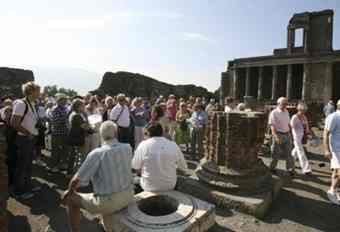For the first-time visitor, there are two stunning things about Pompeii. First, just how vast it is – it really is the size of a proper town. And second, how little there is to see.
 We've all seen images of the haunting frescoes on the living-room walls of the villas of Pompeii's grandees, the statues of Dionysus and the Satyr or the goddess Isis that were found in the town, images of the baker's shop, the pub or the brothel.
We've all seen images of the haunting frescoes on the living-room walls of the villas of Pompeii's grandees, the statues of Dionysus and the Satyr or the goddess Isis that were found in the town, images of the baker's shop, the pub or the brothel.
What we find instead is a fully functioning Autogrill: the company that has a monopoly on Italy's autostrada service stations runs a very useful, and I imagine extremely profitable, cafeteria bang in the middle of the site. And besides that, acres of crumbling, anonymous ruins, which we are barred from exploring by chains. There is also a fairly useful bookshop, but no museum to exhibit at least some of the site's most important relics, and only a handful of houses where the magnificent condition they were in at the time of the eruption can be appreciated.
Pompeii was buried 1,931 years ago after the catastrophic eruption of Vesuvius in AD79. After the city was excavated, its fame spread thanks to its extraordinary state of preservation. Goethe said of it: "Many disasters have befallen the world, but few which have given humanity such delight." Yet today it is hard to understand what all the fuss was about.
You can appreciate the rough delineaments of the town, the stone-paved roads, incised by the wheels of ancient carts, the narrow alleys that intersect with them, the fine forum with its temple and ruined columns, the stadium in an excellent state of repair. Beyond those points of reference, however, everything is fuzzy. Pompeii was once a flourishing place full of character and beauty, but now it's just disintegrating clumps of ancient masonry, stretching away in every direction.
Of course the de-construction of Pompeii has been going on ever since it was first uncovered. Pompeii's marble was stripped for use in new construction, the frescoes were hacked off and carted away to the Archaeological Museum in Naples. The removal of the treasures made sense as a way of preserving them and allowing scholars to study them. Engravings published in 1781 show statuary and other treasures being hauled through the streets of Naples by teams of oxen to the museum which is still home to most of them. Due to cuts imposed by the Ministry of Culture, though, many of the galleries are today closed in rotation.
But what has happened to the site since the end of the Second World War is something quite different. Indifference, lack of resources, lack of good leadership and the numbing Italian state bureaucracy have conspired to accelerate the decline of Pompeii to the point that today it is questionable whether or not it can be salvaged.
The problem is us. We pour through Pompeii and its lesser-known sister site, Herculaneum, in such numbers, millions of us every year, that our impact is comparable to the impact we have on our own homes and streets and towns. The daily population of these sites, the activity on their streets, is not significantly less than it must have been 2,000 years ago.
The difference is that in our own homes we leap into action if the roof starts leaking. Our streets are cleaned, our sewers and roads maintained on a regular basis. But since 1945 Pompeii has been treated as if it has no need of attentions of this sort, simply because nobody actually lives there. Galloping decay is the inevitable result.
Andrew Wallace-Hadrill, the British archaeologist who has been leading a project to rescue Herculaneum for the past decade, says, "There is an assumption that by digging stuff up you have redeemed it, you've saved it. Except you haven't. The laws of physics say it's stable underground. Whatever trauma happened to it at the moment of the eruption, it reaches a stable state. And of course that's why it comes out in such great condition.
"But the moment you excavate, you start the clock again – the clock that says, you built the house for yourself today, the maintenance bills start tomorrow. It comes back to life, which means it's mortal again, so it starts dying."
Pompeii's years of glory culminated in the long career of Amedeo Maiuri, superintendent throughout the Fascist years. He turned both sites into great popular attractions, restoring many houses and shops to the sort of decorative state they were in at the point when they were inundated, and exhibiting the items found within them in showcases. He was helped by the fact that Mussolini saw in the sites a great source of patriotic propaganda, advertising the age and splendour of Italian civilisation.
But Maiuri's retirement was followed by decades of apathy and incompetence, with the results that we see today: millions of tourists tramping through the few remaining gems that are still open to visitors, the House of Pansa, the House of the Little Fountain, the House of the Faun, with their flaking frescoes and reproduction statues, then getting back on their buses.
The concentration of such numbers on a handful of sites ensures that they, too, in their turn will soon have to be closed. And what will we all do then? Read our guidebooks in the sterile comfort of the Autogrill, toss our unfinished panini at the stray dogs, and hope that we are in time to make it to the museum in Naples before it closes.
Source: The Independent [July 03, 2010]